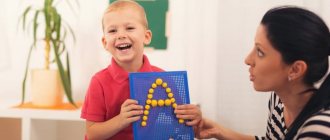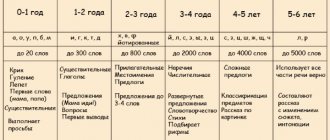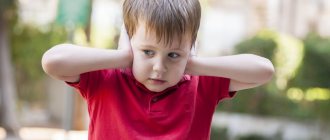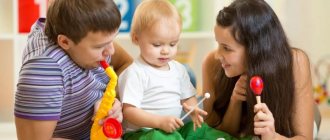Approximate characteristics of a preschool child with speech impairment
Tatyana Shcherbinina
Approximate characteristics of a preschool child with speech impairment
Ekaterina entered the senior group of MBDOU combined kindergarten No. 2 “Smile” at the age of 5 with a diagnosis of delayed speech development.
Speech environment
There is no multilingualism in the family; the older brothers attended a speech therapy group with a diagnosis of general speech underdevelopment. Parents pay enough attention to the upbringing and education of their daughter, are interested in the child’s problems, consult with teachers, and follow the recommendations of specialists.
Manual motor skills:
fine motor skills of the hands are not sufficiently developed; leading hand right; Heda performs tests slowly, requiring repeated repetition of instructions. When performing exercises on the dynamic organization of movements (“Ring – bunny – goat”, etc.), inaccuracies are also observed.
General motor skills.
There is a slow switchability of movements, coordination is impaired.
Articulatory apparatus.
The palate is high, the hyoid frenulum is shortened. Hyperkinesis of the tongue is observed, the volume, accuracy of movements performed, and salivation suffer.
Speech motor skills are underdeveloped. Limited range of upward movements of the tongue, unable to maintain an articulatory posture for a long time.
General sound of speech.
Speech is slurred; uses simple common sentences. Makes mistakes due to insufficient development of the lexical and grammatical aspects of speech. The statements are intonationally unexpressive. There is no logical stress. The voice is weakly modulated, there is a nasality.
Active vocabulary reduced. He uses many words in an approximate meaning (for example, “mug - cup”). Katya knows general concepts: “toys”, “vegetables”, “fruits”, “clothes”, “dishes”, “furniture”, “flowers”. Names the sequence of seasons, days of the week, parts of the day with stimulating help. Passive vocabulary prevails over active one. The use of verbs and adjectives suffers the most. The speech contains few adverbs and complex prepositions.
The grammatical structure of speech.
Agrammatisms are observed when forming adjectives from nouns (for example, “apricot juice”); in agreement of nouns with numerals 1,2,5 (for example, “5 buckets”, “5 trees”, “5 chairs”). In speech he mainly uses simple common sentences.
Phonemic perception, sound analysis and synthesis.
There are difficulties in sound-letter analysis due to insufficient development of thinking operations (analysis and synthesis, for example, does not name the final vowel sound, does not form a word from individual sounds. Katya does not determine the sequence and number of sounds in a word, the place of a sound in a word. Phonemic representations are not sufficiently formed.
Sound pronunciation.
Problematic sounds [С], [З], [Л] and their soft pairs are introduced; the sounds [Ш], [Ф] are not sufficiently automated in speech. The sound-syllable structure of the word is distorted. There are omissions of syllables (for example, “tevizol” - TV, “visiped” - bicycle). Words with a complex syllabic structure are grossly distorted.
Katya knows and names some letters of the alphabet, reads closed syllables with the letters she has learned. When retelling the text, he misses the main events, as a result of which the meaning of the text is lost. The retelling is carried out using help (leading questions, repeated reading to adults). When compiling a story based on a series of plot pictures, organizing and teaching assistance is required; it is difficult to program coherent statements.
Information about himself is formed, family ties are established. Spatial orientation skills are not fully developed, and poor understanding of the basic concepts of time.
Cognitive interests in the educational sphere are not sufficiently formed, voluntary attention is unstable and quickly depleted.
Situations of success evoke positive emotions in the child. The reaction to approval and remark is adequate.
Relationships with adults are stable. He willingly comes into contact with peers, but prefers to play with the same children, loves role-playing games, but is reluctant to obey the general rules of the game, prefers leading roles.
It should be noted that Katya is careful, responsive to adult requests, and helps teachers.
Speech therapy diagnosis:
General speech underdevelopment, level III of speech development.
How to help a mentally retarded child master speech
A speech therapy program for children with mental retardation according to the Federal State Educational Standard is specially developed after diagnosis by the teaching staff. The research results are displayed immediately after the examination.
Work program on speech therapy for mentally retarded children according to the Federal State Educational Standard
For each unpronounceable sound, a program should be developed in which children can improve their speech skills. Lessons in non-verbal and partially verbal communication will allow the preschooler to restore the articulatory apparatus.
Independent speech skills
The first and second stages of the program involve diagnosing and preparing children for classes. Fine motor skills, speech, attention, and thinking also develop here. The lack of development of one element in the process suspends the normal development of speech.
Third stage. Sounds are corrected, phonemic hearing develops, vocabulary expands, and correct speech is built on the basis of lexical and grammatical definitions.
Fourth stage. After the course of the speech therapy program, an assessment is given and the result is compared with the initial lesson.
Guidelines for writing characteristics for children with speech impairments for PMPK
Recommendations are drawn up in the form of a small protocol, which indicates the structure of the speech apparatus, hearing assessment, and mental health. As a result, a conclusion is made, the result is displayed and a speech therapy diagnosis is made.
Speech therapy characteristics for a child with level 3 neurodevelopmental disorders at the primary medical complex
Vetvitskaya Anastasia goes to Kindergarten No. 14. Speech is not developed correctly, she cannot pronounce the sounds K, G, D, T. The motor skills of her fingers act passively and do not obey. Parents did not suffer from speech pathology in childhood. The right hand predominates in movements over the left. The facial structure complies with the norms. The task of frowning eyebrows and wrinkled cheeks is poorly performed. Facial muscles are poorly developed.
Speech lessons
The structure of the mouth. Language. The root is in a tense state, the tip is passive, flaccid, the general structure corresponds to the norm.
Speech is incomprehensible, monotonous, voice is ringing. In the task to repeat a sentence, he misses syllables and does not pronounce some letters. Has a small vocabulary, misses pronouns in communication, and may confuse prepositions in tense.
Speech development of a child up to one year old
Result: observation showed that the child has a level 3 speech disorder.
Speech therapy characteristics for a child with level 2 neurodevelopmental disorders at primary care
Denis Tukonov is in the senior group, his family is complete, his parents have higher education. The presence of speech pathologies was not identified.
Motor skills are poorly developed, movements are slow, often inhibited.
The anatomical structure of the speech apparatus is without any peculiarities: the structure of the face corresponds to the norm. The milk teeth are being replaced by permanent ones. The hypoglossal ligament is without any features (not stretched, not shortened). There is hypotonicity of the lingual muscle.
Speech is not expressive, sounds are poorly pronounced, and the conversation is incomprehensible to others. The voice is quiet, dull. Facial expressions function poorly.
Hearing from the phonemic level is not sufficiently formed. During a conversation, he mixes unvoiced and voiced sounds. The outline of the word is pronounced unclearly and illegibly.
The structure of speech on a grammatical basis is not well developed. The experiment showed gross underdevelopment of coherent speech. Denis retold 1-2 sentences instead of a full semantic story.
Note! Mental health is normal.
Result: Observation established level 2 speech underdevelopment.
An approximate plan for writing a speech therapy profile for a child with level 4 ODD at the PMPK
Preparatory group, Ksenia Zhuravskaya goes to classes every day, communicates with her peers as best she can. The family is complete and prosperous. There are no speech disorders on the part of the parents. Relatives actively take part in speech development: they conduct independent classes at home.
General motor skills suffer, coordination of movements is impaired, inaccuracies in motor processes and inhibition are noticeable. The right hand is the main one.
The anatomical location of the speaking apparatus in the oral cavity corresponds to the norm. The hypoglossal ligament is normal. The tongue is in tense tone and inactive. The teeth are replaced with molars. When performing articulation tasks, muscle spasms appear. In conversation, syntactic sentence structures are used. Retells the story from pictures independently, using a wide vocabulary. Presents the story accurately and assembles the story logically.
Result: as a result of observation, the commission diagnosed speech underdevelopment as level 4, nvonr.










